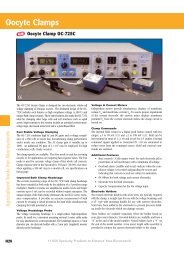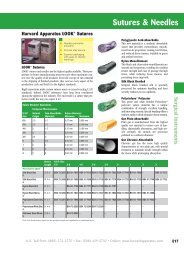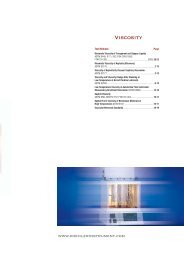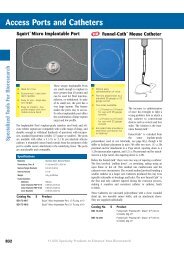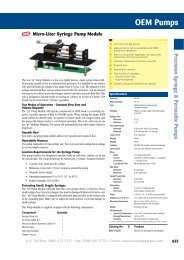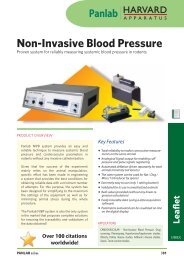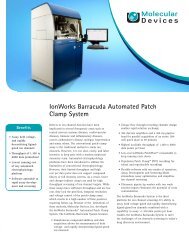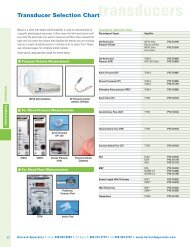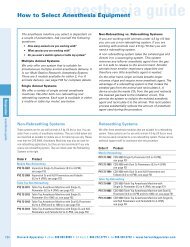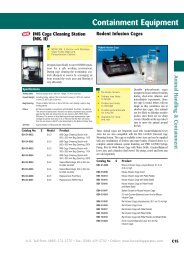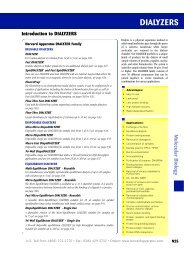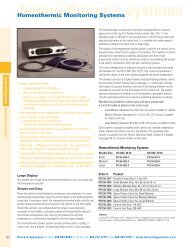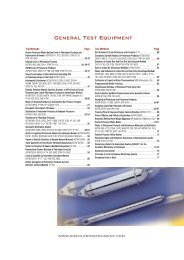Stimulators, Isolators
Stimulators, Isolators
Stimulators, Isolators
Create successful ePaper yourself
Turn your PDF publications into a flip-book with our unique Google optimized e-Paper software.
Blood Pressure Monitor and Transducer<br />
BP1 SPECIFICATIONS<br />
AMPLIFICATION x1, x10, x100, variable (x5 to x1000)<br />
BANDWIDTH, SMALL SIGNAL (-3 dB) 300 kHz (x1)<br />
30 kHz (x10)<br />
3 kHz (x100)<br />
0.3 kHz (x1000)<br />
OUTPUT VOLTAGE SWING ± 5 volts<br />
MAXIMUM OUTPUT CURRENT 2 mA<br />
INPUT IMPEDANCE, EACH INPUT 100 k || 0.01 μF<br />
TRANSDUCER APPLIED VOLTS 10 V nominal, varies with load. 25<br />
mA, maximum<br />
DIGITAL PANEL METER 0 to 1999 mV (calibrated in mm of Hg<br />
pressure when supplied with pressure<br />
gauge). Meter reads average value or<br />
± peak (1 to 20 Hz).<br />
POWER 95-135 V or 220-240 V, 50/60 Hz<br />
DIMENSIONS 8.5x5.12x10 in. (21.6x13x25.44 cm)<br />
SHIPPING WEIGHT 11 lb (5 kg)<br />
BLPR2 SPECIFICATIONS<br />
WORKING PRESSURE -50 to + 300 mm Hg<br />
OVERPRESSURE -400 to +4000 mm Hg<br />
EXCITATION VOLTAGE 1-10 VDC or RMS to 5 kHz<br />
INPUT IMPEDANCE 350 ±10%<br />
OUTPUT IMPEDANCE 300 ±10%<br />
ISOLATION < 5 μA leakage at 120 VAC<br />
SENSITIVITY 5 μV/V/mm Hg<br />
DYNAMIC RESPONSE 100 Hz<br />
EIGHT HOUR DRIFT 1 mm Hg after 5 minute warm-up<br />
MAXIMUM ERROR Total combined effects of Sensitivity, Linearity,<br />
Hysteresis (at 25°C and 5 μV/V/mm Hg) do not<br />
exceed ±2% or 1 mm Hg, whichever is greater.<br />
ENVIRONMENTAL<br />
Operating Temp. Range +15°C to +40°C<br />
Storage Temp. Range -30°C to +60°C<br />
Light Sensitivity Not affected by light under 3000 ft/candles<br />
(32,000 lux)<br />
SHIPPING WEIGHT 1 lb<br />
Monitors pressure, force, temperature<br />
Monitors animal arterial or venous blood pressure<br />
Displays systolic, diastolic or average blood pressure<br />
BP1 accepts WPI’s BLPR blood pressure transducer (below) as well as other<br />
blood pressure transducers.<br />
An audio monitor provides a signal with variable pitch and amplitude,<br />
allowing you to hear changes in blood pressure. Digital LCD display provides<br />
average or peak signal values from 0 to 1999 mV. With an optional pressure<br />
gauge (not provided — see PM015D/R, page 235), the user may calibrate the<br />
display to read mm Hg. Recorder output connector allows direct connection to<br />
a pen recorder, oscilloscope or computer via a data acquisition system.<br />
SYS-BP1<br />
ACCESSORIES<br />
Pressure Monitor (transducer & cable not included)<br />
Specify line voltage<br />
BLPR2 NEW Blood Pressure Transducer & Cable<br />
BPCABLE2 NEW Cable (12 ft) with DIN connector for BLPR2<br />
503067 BLPR2 Transducer without cable<br />
13024 Single Rack Mount Kit<br />
13025 Dual Rack Mount Kit<br />
3491 Extension Cable, 5 ft<br />
500184 BNC-to-BNC Cable, 10 ft<br />
14036-15 4-Way Luer Stopcock, Blue Tint (package of 15)<br />
KZ1101 Micro Cannula, 3 inch<br />
Note: BLPR2 is intended for animal research only and may not be<br />
used for human blood pressure measurement.<br />
BLOOD PRESSURE<br />
TRANSDUCER<br />
Stopcock #14036<br />
included with BLPR2<br />
BLPR2 can be used for the direct arterial and venous pressure measurement<br />
in animal blood vessels. Supplied sterile, BLPR2 is accurate,<br />
linear and stable with temperature. May be sterilized cold with Cidex or a<br />
similar bactericide.<br />
BLPR2 is equipped with a twelve-foot cable and connector compatible<br />
with WPI’s four-channel signal conditioning unit, TBM4M Transbridge,<br />
and the single-channel BP1 blood pressure monitor. Cable has moistureresistant<br />
locking connector. A continuous, uniform lumen eliminates<br />
places for bubbles to form and lodge. The clear fluid path is easy to<br />
inspect. Easy to mount — slotted transducer body accepts Velcro strap.<br />
To facilitate setup and operation, a four-way stopcock that allows easy<br />
filling, flushing, and zeroing of the transducer is included. Typically, the<br />
stopcock is located between the transducer and the animal catheter<br />
where it can be used to quickly zero, flush, or de-bubble the transducer.<br />
Prices shown are in U.S. dollars. Actual charges will vary because of import duty, freight, and currency fluctuations. To obtain an exact quotation, contact your WPI office.<br />
World Precision Instruments Tel: Fax: E-mail: Internet: www.wpiinc.com<br />
35<br />
PHYSIOLOGY



